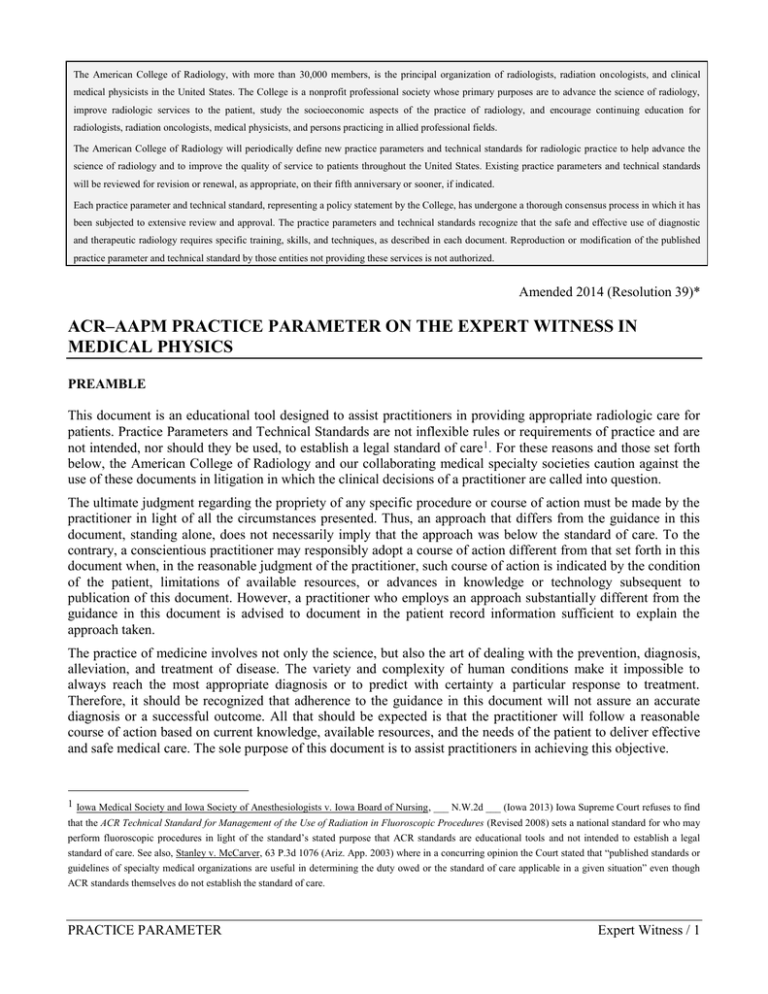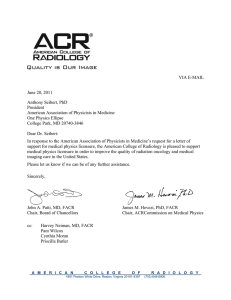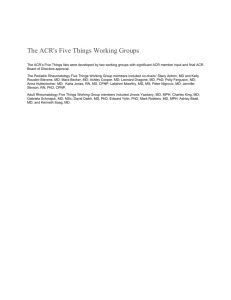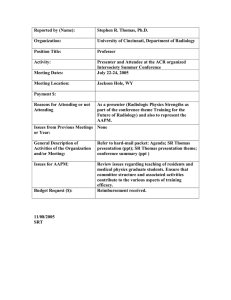Document 14564523
advertisement

The American College of Radiology, with more than 30,000 members, is the principal organization of radiologists, radiation oncologists, and clinical medical physicists in the United States. The College is a nonprofit professional society whose primary purposes are to advance the science of radiology, improve radiologic services to the patient, study the socioeconomic aspects of the practice of radiology, and encourage continuing education for radiologists, radiation oncologists, medical physicists, and persons practicing in allied professional fields. The American College of Radiology will periodically define new practice parameters and technical standards for radiologic practice to help advance the science of radiology and to improve the quality of service to patients throughout the United States. Existing practice parameters and technical standards will be reviewed for revision or renewal, as appropriate, on their fifth anniversary or sooner, if indicated. Each practice parameter and technical standard, representing a policy statement by the College, has undergone a thorough consensus process in which it has been subjected to extensive review and approval. The practice parameters and technical standards recognize that the safe and effective use of diagnostic and therapeutic radiology requires specific training, skills, and techniques, as described in each document. Reproduction or modification of the published practice parameter and technical standard by those entities not providing these services is not authorized. Amended 2014 (Resolution 39)* ACR–AAPM PRACTICE PARAMETER ON THE EXPERT WITNESS IN MEDICAL PHYSICS PREAMBLE This document is an educational tool designed to assist practitioners in providing appropriate radiologic care for patients. Practice Parameters and Technical Standards are not inflexible rules or requirements of practice and are not intended, nor should they be used, to establish a legal standard of care1. For these reasons and those set forth below, the American College of Radiology and our collaborating medical specialty societies caution against the use of these documents in litigation in which the clinical decisions of a practitioner are called into question. The ultimate judgment regarding the propriety of any specific procedure or course of action must be made by the practitioner in light of all the circumstances presented. Thus, an approach that differs from the guidance in this document, standing alone, does not necessarily imply that the approach was below the standard of care. To the contrary, a conscientious practitioner may responsibly adopt a course of action different from that set forth in this document when, in the reasonable judgment of the practitioner, such course of action is indicated by the condition of the patient, limitations of available resources, or advances in knowledge or technology subsequent to publication of this document. However, a practitioner who employs an approach substantially different from the guidance in this document is advised to document in the patient record information sufficient to explain the approach taken. The practice of medicine involves not only the science, but also the art of dealing with the prevention, diagnosis, alleviation, and treatment of disease. The variety and complexity of human conditions make it impossible to always reach the most appropriate diagnosis or to predict with certainty a particular response to treatment. Therefore, it should be recognized that adherence to the guidance in this document will not assure an accurate diagnosis or a successful outcome. All that should be expected is that the practitioner will follow a reasonable course of action based on current knowledge, available resources, and the needs of the patient to deliver effective and safe medical care. The sole purpose of this document is to assist practitioners in achieving this objective. 1 Iowa Medical Society and Iowa Society of Anesthesiologists v. Iowa Board of Nursing, ___ N.W.2d ___ (Iowa 2013) Iowa Supreme Court refuses to find that the ACR Technical Standard for Management of the Use of Radiation in Fluoroscopic Procedures (Revised 2008) sets a national standard for who may perform fluoroscopic procedures in light of the standard’s stated purpose that ACR standards are educational tools and not intended to establish a legal standard of care. See also, Stanley v. McCarver, 63 P.3d 1076 (Ariz. App. 2003) where in a concurring opinion the Court stated that “published standards or guidelines of specialty medical organizations are useful in determining the duty owed or the standard of care applicable in a given situation” even though ACR standards themselves do not establish the standard of care. PRACTICE PARAMETER Expert Witness / 1 I. INTRODUCTION This practice parameter was developed collaboratively by the American College of Radiology (ACR) and the American Association of Physicists in Medicine (AAPM). Medical physicists are frequently called upon to serve as medical expert witnesses in a variety of legal proceedings and have a professional obligation to do so in the appropriate circumstances. Medical expert witness testimony is indicated in any legal proceeding in which the court needs an objective Qualified Medical Physicist who is not a party to the case, has no personal interest in the outcome of the case, and has expertise in the matter at hand to help explain the issues [1]. II. QUALIFICATIONS AND RESPONSIBILITIES OF THE EXPERT WITNESS A. Qualifications The expert witness should be a Qualified Medical Physicist with the following qualifications: A Qualified Medical Physicist is an individual who is competent to practice independently in one or more of the subfields in medical physics. The American College of Radiology considers certification, continuing education and experience in the appropriate subfield(s) to demonstrate that an individual is competent to practice one or more of the subfields in medical physics, and to be a Qualified Medical Physicist. The ACR strongly recommends that the individual be certified in the appropriate subfield(s) by the American Board of Radiology (ABR), the Canadian College of Physicists in Medicine, or the American Board of Medical Physics (ABMP). A Qualified Medical Physicist should meet the ACR Practice Parameter for Continuing Medical Education (CME). (ACR Resolution 17, adopted in 1996 – revised in 2012, Resolution 42). All subfields of medical physics apply to this practice parameter. The Qualified Medical Physicist expert witness should currently be practicing in the subfield or subject of expert testimony. B. Responsibilities The Qualified Medical Physicist expert witness may be called upon to provide one or more of the following services: 1. Expert analysis of the incident and data of the case and providing information (oral or written) to attorneys for the case on behalf of either the plaintiff or the defense. 2. Provide a legal deposition for the case on behalf of either the plaintiff or defense. 3. Appear in court as an expert witness on behalf of either the plaintiff or defense. Qualified Medical Physicist expert witnesses should confine their testimony to their areas of expertise on a scientific impartial basis. This is particularly important when appearing in court as an expert witness. Expert Witness PRACTICE GUIDELINE 2013 Resolution No. 43 III. REQUISITES OF AN EXPERT WITNESS An individual holding an official capacity with the AAPM or the ACR who testifies in a legal proceeding must exercise great care to distinguish between his or her personal opinions and the policy positions of the ACR2 and the AAPM [2]. Medical physicists who are members of the AAPM are obligated to abide by the AAPM Code of Ethics. The Qualified Medical Physicist expert witness should: A. Be impartial and should not adopt a position as an advocate or partisan in the legal proceedings. B. Review the facts in the case and testify to the contents of the case fairly and impartially. C. Review the standards and the state of the art of the subject matter prevailing at the time of the occurrence. D. Be prepared to state the basis of the testimony presented, and whether it is based on personal experience, specific references, or generally accepted opinion in the areas of specialization of the Qualified Medical Physicist expert witness. E. Be aware that transcripts and courtroom testimony are public records, subject to independent peer review. F. Not testify in cases in which they may have a conflict of interest. Compensation of the Qualified Medical Physicist expert witness should be reasonable and commensurate with the time and effort given to preparing for deposition and court appearance. It is inappropriate to link compensation with the outcome of the case. ACKNOWLEDGEMENTS This guideline was revised according to the process described under the heading The Process for Developing ACR Practice Guidelines and Technical Standards on the ACR web site (http://www.acr.org/guidelines) by the Guidelines and Standards Committee of the ACR Commission on Medical Physics in collaboration with the AAPM. Collaborative Committee – members represent their societies in the initial and final revision of this guideline ACR J. Thomas Payne, PhD, FACR, FAAPM, Co-Chair Per H. Halvorsen, MS, FACR, FAAPM AAPM Christopher F. Serago, PhD, FACR, FAAPM, FACMP, Co-Chair Jeff P. Masten, MA, JD, BS, MS Robert J. Pizzutiello Jr., MS, FACR, FAAPM, FACMP 2 The policies of the College are a matter of public record and, if relevant, may be appropriately cited in testimony. Also, the fact that an individual holds an official position with the College may be an appropriate part of his or her qualifications as an expert witness. However, the College, except pursuant to specific action by the Board of Chancellors, does not take a position on the merits of particular cases. A witness who holds an official capacity with the College must therefore be at pains to make clear that his or her testimony expresses his or her personal views and must not state or imply in a written opinion or deposition or trial testimony that he or she is speaking as a representative of the College or is testifying to the views of the College on the merits of a particular case (1987, 1997, 2007 – ACR Resolution 36-v). PRACTICE PARAMETER Expert Witness / 3 Committee on Practice Parameters and Technical Standards – Medical Physics (ACR Committee responsible for sponsoring the draft through the process) Tariq A. Mian, PhD, FACR, FAAPM, Chair Maxwell R. Amurao, PhD, MBA Ishtiaq H. Bercha, MSc Chee-Wai Cheng, PhD, FAAPM Laurence E. Court, PhD Nicholas J. Hangiandreou, PhD Bruce E. Hasselquist, PhD Ralph P. Lieto, MS, FACR, FAAPM Jeffrey P. Limmer, MSc Matthew A. Pacella, MS Doug Pfeiffer, MS Thomas G. Ruckdeschel, MS Christopher J. Watchman, PhD Gerald A. White, Jr., MS, FACR, FAAPM John W. Winston, Jr., MS Richard A. Geise, PhD, FACR, FAAPM, Chair, Medical Physics Commission Debra L. Monticciolo, MD, FACR, Chair, Quality and Safety Commission Julie K. Timins, MD, FACR, Chair, Committee on Practice Parameters and Technical Standards Comments Reconciliation Committee Jonathan Breslau, MD, FACR, Chair Tariq A. Mian, PhD, FACR, FAAPM, Co-Chair Kimberly E. Applegate, MD, MS, FACR Leonard Berlin, MD, FACR Howard B. Fleishon, MD, MMM, FACR Richard A. Geise, PhD, FACR, FAAPM Per H. Halvorsen, MS, FACR, FAAPM Jeff P. Masten, MA, JD, BS, MS Debra L. Monticciolo, MD, FACR J. Thomas Payne, PhD, FACR, FAAPM Robert J. Pizzutiello Jr., MS, FACR, FAAPM, FACMP Christopher F. Serago, PhD, FACR, FAAPM, FACMP Julie K. Timins, MD, FACR REFERENCES 1. ACR practice guideline on the physician expert witness in radiology and radiation oncology. http://www.acr.org/SecondaryMainMenuCategories/quality_safety/guidelines/dx/expert_witness.aspx. Accessed April 18, 2012. 2. American Association of Physicists in Medicine. Medical Physicist Expert Witness. College Park, Md. Policy Number PP 3-C; 2008. *Practice parameters and technical standards are published annually with an effective date of October 1 in the year in which amended, revised, or approved by the ACR Council. For practice parameters and technical standards published before 1999, the effective date was January 1 following the year in which the practice parameter or technical standard was amended, revised, or approved by the ACR Council. 4 / Expert Witness PRACTICE PARAMETER Development Chronology for this Practice Parameter 2013 (Resolution 43) Amended 2014 (Resolution 39) PRACTICE PARAMETER Expert Witness / 5


